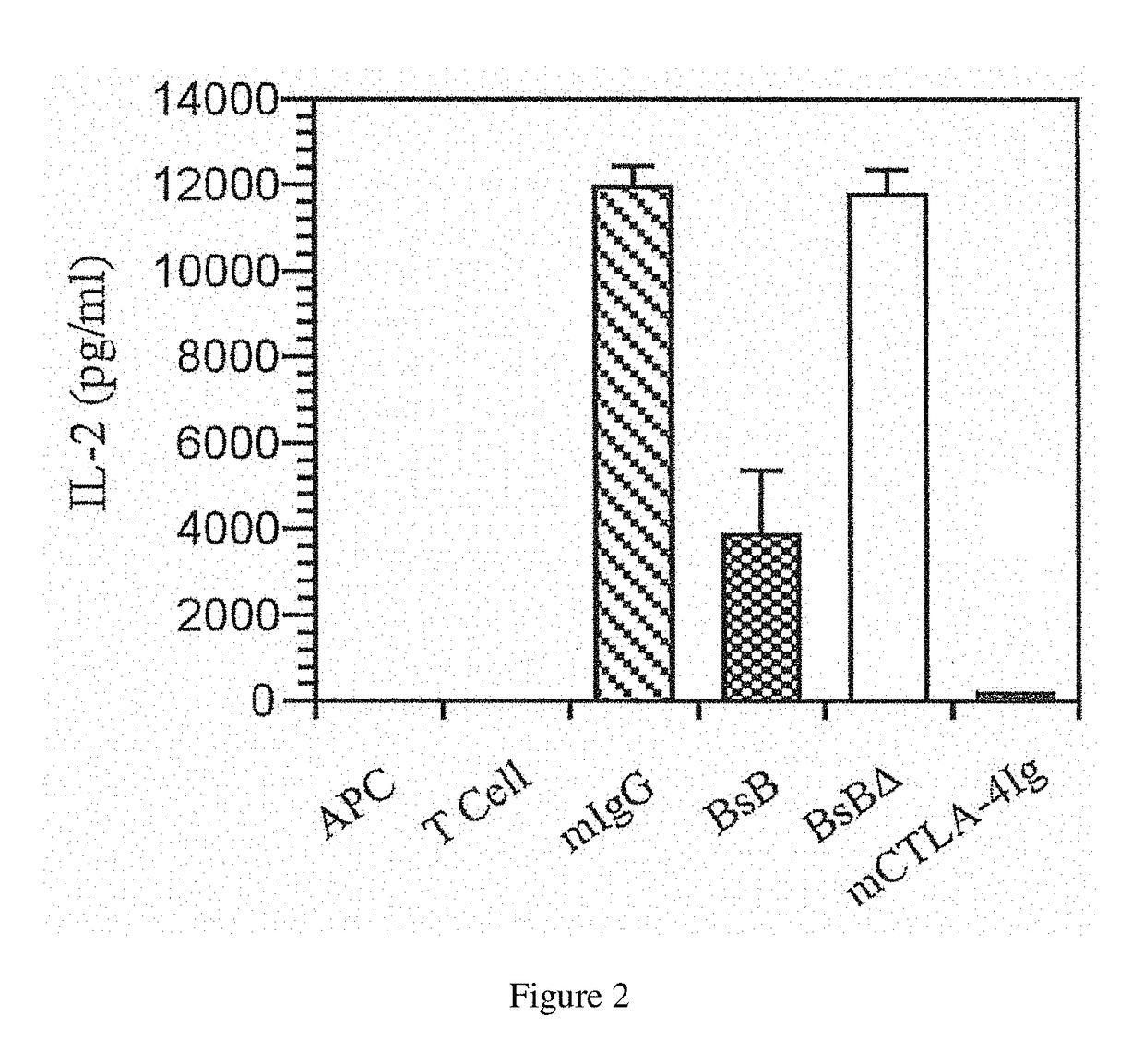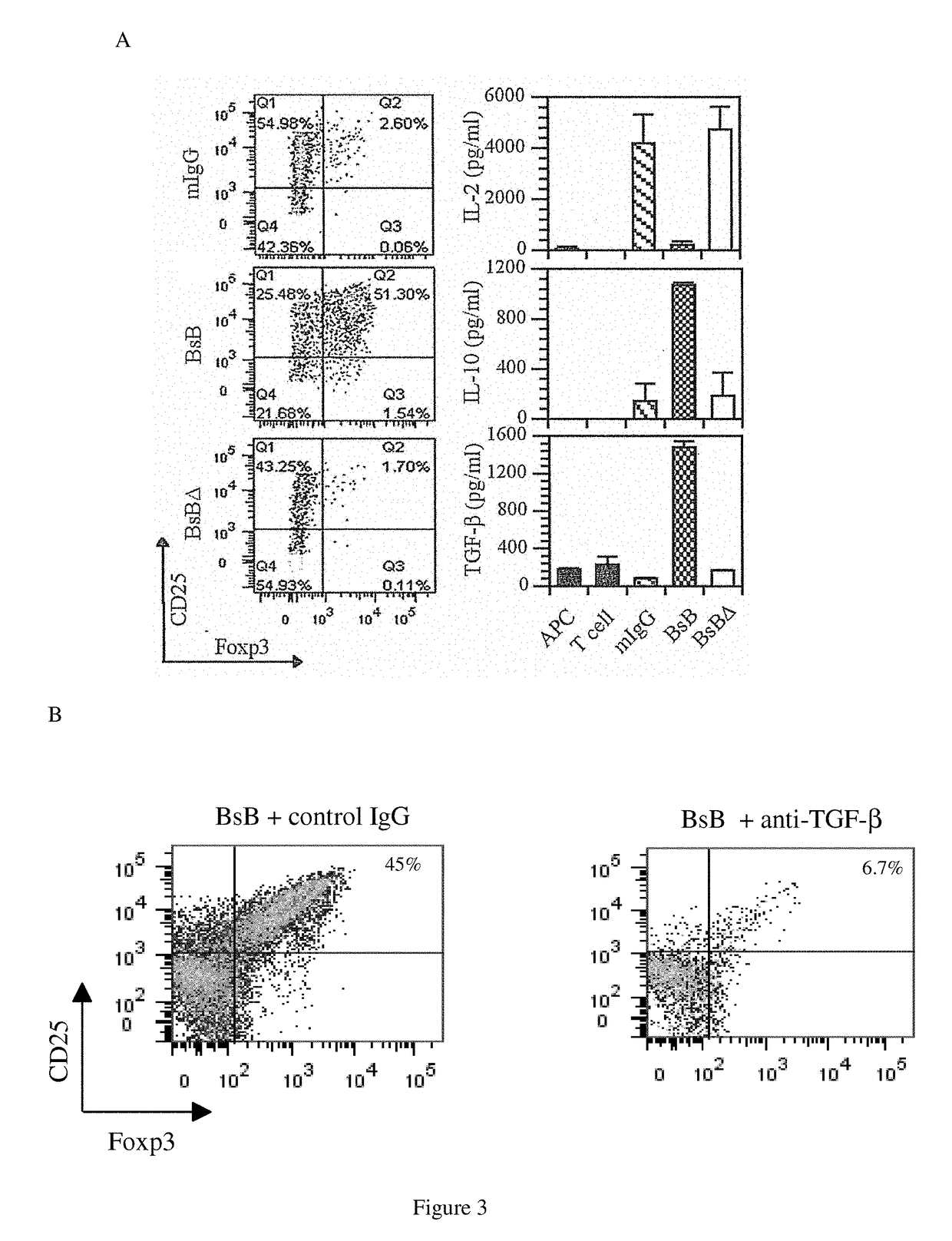Inhibitors of T-cell activation
a technology of t-cell activation and inhibitors, which is applied in the direction of peptide sources, immunological disorders, metabolism disorders, etc., can solve the problems of reducing the incidence of animals presenting with diabetes, and achieve the effect of stimulating anti-inflammatory cytokines il-10 and inhibiting t-cell activation
- Summary
- Abstract
- Description
- Claims
- Application Information
AI Technical Summary
Benefits of technology
Problems solved by technology
Method used
Image
Examples
example 1
Design of a Bispecific Fusion Protein that Engages CTLA-4 and Crosslinks it to the TCR Via MHC 11.
[0137]To generate a bispecific fusion protein that selectively and agonistically engages CTLA-4 and simultaneously ligates it to the TCR, mutant CD80 (CD80w88a, referred to hereafter as CD80wa) that binds CTLA-4 but has minimal affinity for CD28 (Wu et al., 1997) was fused to LAG-3, a natural ligand of MHCII (Baixeras et al., 1992; Triebel et al., 1990). CD80wa was joined to LAG-3 using a linker composed of nine glycines, which in turn was attached to the Fc portion of mouse IgG2a to purportedly increase its circulating half-life (FIG. 1A). In response to a ligand of this configuration, CTLA-4 engagement and ligation to the TCR were expected to occur indirectly, via formation of the tri-molecular complex (CTLA-4 / MHCII / TTCR) in the immune synapses during early T cell activation (FIG. 1B). Conceptually, outside of the context of the immune synapse, binding of the bispecific fusion protein...
example 2
BsB Inhibits T Cell Activation in an Allogenic Mixed Lymphocyte Reaction.
[0139]The relative ability of BsB and BsBΔ to inhibit T cell activation was assessed in an allogenic mixed lymphocyte reaction by measuring the production of IL-2. Naïve CD4+CD25− CD62LhighCD44low T cells that had been purified from BALB / c mice were mixed with APCs isolated from C57BL / 6 mice in the presence or absence of the BsB or BsBΔ. Murine IgG2a and CTLA-4Ig, a co-stimulation inhibitor that binds to CD80 / 86 and blocks their binding to CD28, were included as negative and positive controls, respectively. Inclusion of BsB but not BsBΔ in the mixed lymphocyte reaction inhibited IL-2 production albeit not to the same extent as that achieved by CTLA-4Ig (FIG. 2). This difference was likely the result of BsB-mediated T cell inhibition occurring later than CTLA-4Ig-mediated inhibition. More specifically, for BsB, inhibition only occurred after CTLA-4 was upregulated following T cell activation. The inability of Bs...
example 3
BsB Directs T Cell Differentiation into Tregs.
[0140]Early termination of TCR signaling by withdrawal of antigen stimulation, inhibition of mTOR signaling, suboptimal TCR stimulation due to a low affinity antigen, or weak co-stimulation during T cell activation have been shown to induce Foxp3+ expression and skew T cell differentiation toward a Treg phenotype (Delgoffe et al., (2009) Immunity 30:832-844; Haxhinasto et al., (2008) J. Exp. Med. 205:565-574; Sauer et al., (2008) Proc. Natl. Acad. Sci. USA 105:7797-7802). As BsB forces early engagement of the TCR by activation-induced CTLA-4 with consequent attenuation of TCR signaling, its ability to generate Foxp3+ Tregs was also evaluated. Naïve CD4+CD62LhighGFP″ T cells prepared from Foxp3-EGFP knock-in mice (Haribhai et al., (2007) J. Immunol. 178:2961-2972) were mixed with LPS-treated allogenic APCs in the presence of BsB or BsBΔ. Flow cytometry analysis of the cells after five days of culture revealed a large number of CD4+CD25+GF...
PUM
| Property | Measurement | Unit |
|---|---|---|
| weight | aaaaa | aaaaa |
| weight | aaaaa | aaaaa |
| pH | aaaaa | aaaaa |
Abstract
Description
Claims
Application Information
 Login to View More
Login to View More - R&D
- Intellectual Property
- Life Sciences
- Materials
- Tech Scout
- Unparalleled Data Quality
- Higher Quality Content
- 60% Fewer Hallucinations
Browse by: Latest US Patents, China's latest patents, Technical Efficacy Thesaurus, Application Domain, Technology Topic, Popular Technical Reports.
© 2025 PatSnap. All rights reserved.Legal|Privacy policy|Modern Slavery Act Transparency Statement|Sitemap|About US| Contact US: help@patsnap.com



